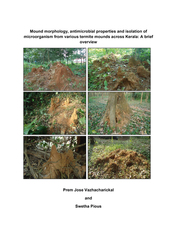| Fachbereiche | |
|---|---|
| Buchreihen (96) |
1378
|
| Nachhaltigkeit |
3
|
| Gesundheitswesen |
1
|
| Geisteswissenschaften |
2364
|
| Naturwissenschaften |
5406
|
| Mathematik | 229 |
| Informatik | 319 |
| Physik | 980 |
| Chemie | 1363 |
| Geowissenschaften | 131 |
| Humanmedizin | 243 |
| Zahn-, Mund- und Kieferheilkunde | 10 |
| Veterinärmedizin | 108 |
| Pharmazie | 147 |
| Biologie | 835 |
| Biochemie, Molekularbiologie, Gentechnologie | 121 |
| Biophysik | 25 |
| Ernährungs- und Haushaltswissenschaften | 45 |
| Land- und Agrarwissenschaften | 1004 |
| Forstwissenschaften | 201 |
| Gartenbauwissenschaft | 20 |
| Umweltforschung, Ökologie und Landespflege | 148 |
| Ingenieurwissenschaften |
1793
|
| Allgemein |
98
|
|
Leitlinien Unfallchirurgie
5. Auflage bestellen |
|
Erweiterte Suche
Mound morphology, antimicrobial properties and isolation of microorganism from various termite mounds across Kerala
A brief overview
Swetha Pious (Autor)Prem Jose Vazhacharickal (Autor)
Vorschau
Leseprobe, Datei (610 KB)
Inhaltsverzeichnis, Datei (550 KB)
Termites are important component in ecosystem. Termite mounds play a major role in post-clearing landscapes and they constrain re-colonization of the land scale by vegetation. A comparative study between 9 different termite mounds in Kerala was conducted. For this purpose investigated the physical, chemical, morphological and antimicrobial properties of termite mound soil of selected termite mounds. Considerable differences were observed during morphological comparison of different termite mounds. Each mound differed in height, colour, soil texture etc. Termite mound soil possesses an acidic pH. Also termite mounds vary in their total inorganic carbon, T.S.S, P and K respectively. And it was observed to be high in M6 among the others. Due to the organic decomposition and fecal matter deposition termite mound soil has some slight antimicrobial activity. For this purpose four mounds were randomly selected and tested its antimicrobial property by preparing the extract using three different reagents. Extract prepared using methanol showed a considerable range of zone formation. Two types of microorganism were used for this purpose. There were also some microbial populations present in association with the termite mounds that were different in their colony morphology. Majority of them were fungus. However microbial populations were observed to be high in M6 that has a synergistic effect on organic matter decomposition and nutrient cycling.
| ISBN-13 (E-Book) | 9783736982208 |
| Sprache | Englisch |
| Seitenanzahl | 49 |
| Auflage | 1. |
| Erscheinungsort | Göttingen |
| Erscheinungsdatum | 30.05.2016 |
| Allgemeine Einordnung | Dissertation |
| Fachbereiche |
Land- und Agrarwissenschaften
|
| Schlagwörter | Termites, Kerala |








